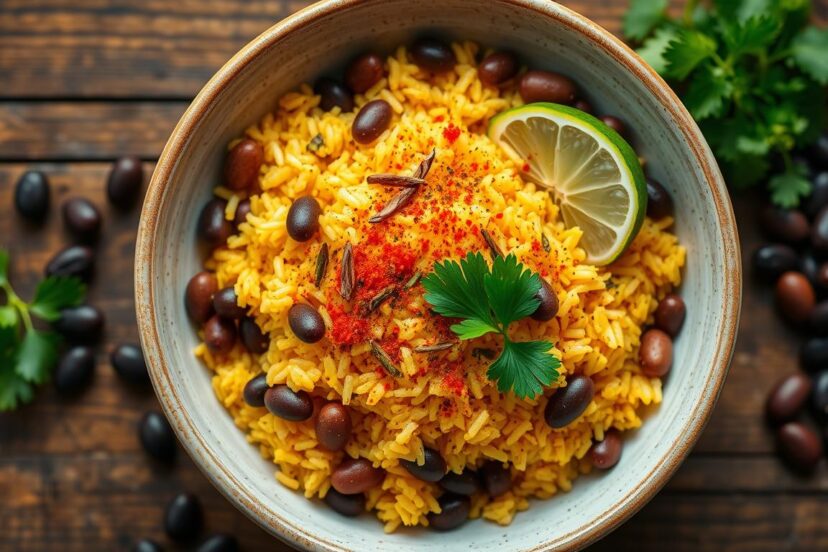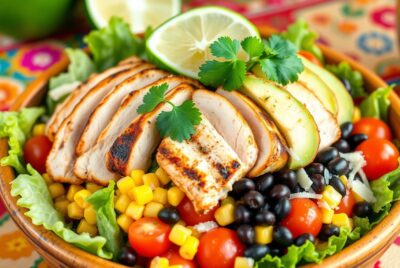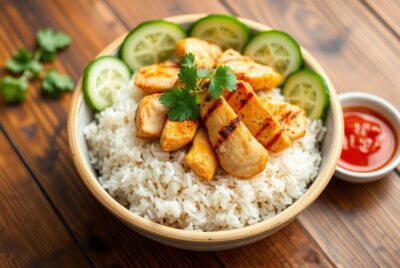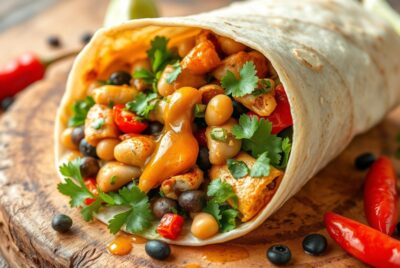Savor the Taste of Curry Rice and Beans
Welcome to a culinary journey where I explore the delightful dish of curry rice and beans, a comforting staple that warms the heart and nourishes the soul. This dish is a fantastic option for anyone searching for vegetarian recipes that offer both flavor and health benefits. I’ll dive into the origins of curry rice and beans, its nutritional advantages, and the various cooking techniques that can elevate this meal into a wholesome experience. Whether you are a seasoned cook or a beginner, you’ll find inspiration to create healthy meals that truly satisfy.
Join me as I share tips and insights on how to embrace this flavorful dish in your kitchen, making curry rice and beans a new favorite in your comfort food repertoire.
Introduction to Curry Rice and Beans
Curry rice and beans represents a perfect fusion of flavors and ingredients, beautifully blending the hearty nature of rice and beans with aromatic spices. This traditional dish not only tantalizes the taste buds but also nourishes the body with its wholesome ingredients. The vibrant colors and rich flavors make it a popular choice across various cultures.
What is Curry Rice and Beans?
This delectable dish typically consists of rice paired with beans, cooked together with a mixture of spices in a savory curry sauce. It often features a variety of beans such as black beans or kidney beans, complemented by basmati or jasmine rice. The preparation allows for flexibility in choosing spices, enabling each cook to add their unique touch that reflects personal or cultural influences. It stands out as a comfort food that can be enjoyed in any season.
The Origins of the Dish
Curry rice and beans has a rich culinary history, traceable to both Caribbean and South Asian cuisines. The introduction of curry spices into local cooking practices during colonial times likely contributed to the dish’s evolution. Over the years, it has transformed into a staple comfort food in numerous regions, showcasing variations that appeal to diverse palates while retaining its essential characteristics. This adaptability speaks volumes about its enduring popularity and significance across different cultures.
Health Benefits of Curry Rice and Beans
Curry Rice and Beans is not just a flavorful dish; it serves as an excellent source of numerous health benefits. Packed with generous nutritional values, these ingredients synergistically contribute to a balanced diet. Understanding the nutritional profile of this meal can help me appreciate its significance in my vegan nutrition journey.
Nutritional Value Overview
This delightful dish offers a variety of essential vitamins and minerals, making it a reliable option for those focused on maintaining a healthy lifestyle. Beans provide dietary fiber, which promotes digestive health and helps in maintaining a healthy weight. The rice complements these benefits, offering easily digestible carbohydrates crucial for energy.
Plant-Based Protein Sources
Beans are a fantastic plant-based protein source that supplies me with the amino acids necessary for muscle repair and growth. In contrast to animal proteins, plant-based proteins often come with lower fat levels, making them heart-healthy options. Incorporating Curry Rice and Beans into my meals not only satisfies my taste buds but also significantly boosts my protein intake while supporting my overall health.
| Nutritional Component | Amount per Serving | Health Benefit |
|---|---|---|
| Protein | 15g | Muscle repair and growth |
| Fiber | 8g | Improves digestive health |
| Iron | 2mg | Essential for oxygen transport |
| Vitamins A & C | Varies | Supports immune health |
Key Ingredients for Your Recipe
Creating the perfect curry rice and beans involves selecting the right key ingredients that enhance flavor and texture. Choosing delicious spices for curry elevates the dish, making it a delightful experience for the palate. Let’s delve into essential spices and the best rice and beans varieties to use.
Essential Spices for Flavor
To achieve a rich and aromatic flavor in my curry rice and beans, I rely on a variety of spices. Here are some of my favorites:
- Turmeric: Gives a vibrant color and earthy taste.
- Cumin: Adds a warm, nutty flavor.
- Coriander: Provides a citrusy and slightly sweet note.
- Garam Masala: A blend of spices that rounds out the flavor profile.
- Red Chili Powder: For those who enjoy some heat.
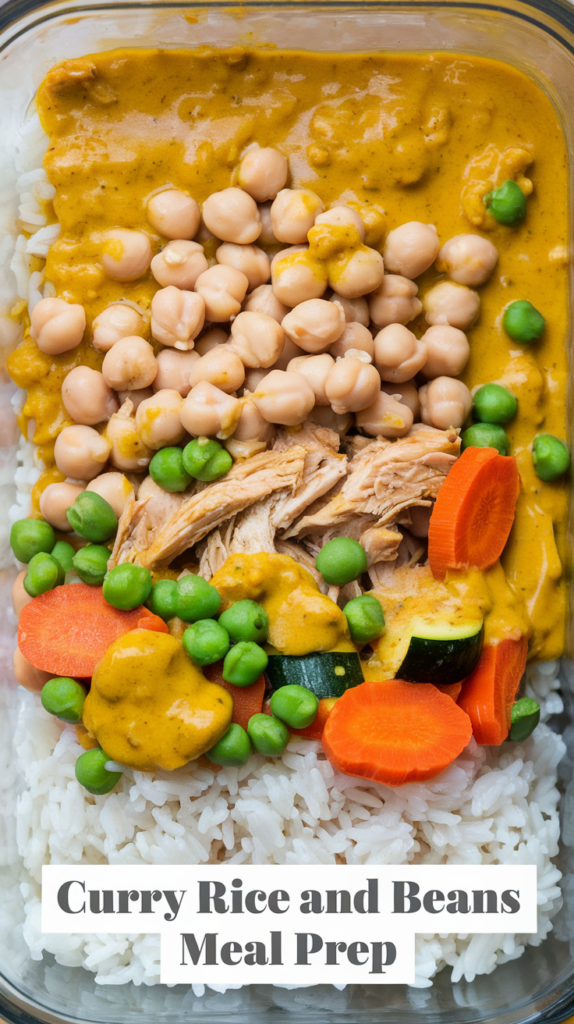
Type of Rice and Beans to Use
Choosing the right rice and beans varieties makes all the difference in texture and taste. Here are some recommendations:
| Rice Varieties | Beans Varieties |
|---|---|
| Jasmine Rice | Black Beans |
| Basmati Rice | Chickpeas |
| Brown Rice | Kidney Beans |
| White Rice | Pinto Beans |
Preparing the Base for Curry Rice and Beans
Creating the perfect recipe base for curry rice and beans begins with mastering the essential techniques for cooking rice and beans preparation. In this section, I’ll provide helpful tips on how to achieve fluffy rice and explore my options for preparing beans, whether dried or canned. This will help streamline my meal prep while ensuring full flavor.
Cooking the Rice Perfectly
Cooking rice might seem straightforward, but achieving that perfect texture can be challenging. Here are a few steps I often follow:
- Choose the right type of rice. Long-grain rice like Basmati works well for this dish.
- Rinse the rice thoroughly before cooking to remove excess starch.
- Use a water-to-rice ratio of 1.5:1 for fluffy results.
- Bring the water to a boil, then cover and simmer on low heat for about 15-20 minutes.
- Allow the rice to rest for 5 minutes off the heat before fluffing with a fork.
Preparing the Beans: Dried vs. Canned
The choice between dried and canned beans can significantly influence the cooking time and flavor. Here’s what I consider:
| Type | Pros | Cons |
|---|---|---|
| Dried Beans |
|
|
| Canned Beans |
|
|

Making the Perfect Curry Sauce
Creating the perfect curry sauce is essential for bringing the flavors of curry rice and beans to life. I find that the right coconut milk contributes to a creamy texture that enhances the overall dish. Choosing high-quality coconut milk sets a solid foundation. It influences not only the texture but also the flavor profile of the curry sauce. Additionally, balancing spice blend recipes creates layers of flavor that make each bite unforgettable.
Choosing the Right Coconut Milk
When selecting coconut milk, I prioritize options that are rich and contain a high percentage of coconut. Often, full-fat coconut milk delivers the best results, providing a luxurious creaminess that works wonders in curry sauce. I recommend brands like Thai Kitchen or Aroy-D. These tend to have a rich flavor and consistently high quality. Reading the label helps avoid those with unnecessary additives, ensuring a pure taste.
Spice Blends to Enhance Flavor
Crafting the right spice blend is crucial for developing the depth of flavor in the curry sauce. I often combine spices such as turmeric, cumin, coriander, and garam masala. Each spice brings its characters, transforming the dish into something extraordinary. Below is a quick reference table showcasing popular spice blends and their flavor notes:
| Spice Blend | Main Flavors |
|---|---|
| Garam Masala | Warm, sweet, and aromatic |
| Madras Curry Powder | Spicy, earthy, and bold |
| Turmeric | Warm, bitter, and golden |
| Cumin | Nutty, warm, and peppery |
| Coriander | Citrus, sweet, and floral |
Cooking Techniques to Try
Exploring various cooking techniques can transform the way I prepare Curry Rice and Beans. Utilizing methods like the one-pot meal and slow cooker recipes streamline my cooking process while still delivering delicious results. Each technique offers a unique set of benefits, making dinner simpler and more enjoyable.
One-Pot Method
The one-pot meal approach simplifies cooking significantly. With this technique, I can combine all ingredients into a single pot, allowing flavors to meld beautifully without a lot of fuss. Here’s how I can do it:
- Start by sautéing onions and spices directly in the pot.
- Add rice and beans, then pour in the necessary liquids.
- Cover and let everything simmer until cooked through.
This method not only saves time but also minimizes cleanup, leaving me with more time to enjoy a delicious and nutritious meal.
Slow Cooker Variations
The slow cooker is a game changer when it comes to easy dinners. I can prepare my Curry Rice and Beans in the morning and have a warm, comforting dish ready by evening. Here are the steps to follow:
- Layer the ingredients in the slow cooker, starting with the harder vegetables and ending with rice and beans on top.
- Pour in coconut milk and spices.
- Set the timer and let the slow cooker work its magic.
This technique allows me to set it and forget it, making it perfect for busy days.
Serving Suggestions for Curry Rice and Beans
When it comes to enjoying Curry Rice and Beans, there are numerous serving ideas that can enhance the overall experience. A well-thought-out meal pairing can elevate the dish from simply satisfying to truly memorable. I love exploring creative serving styles that not only look inviting but also feel festive, perfect for any gathering or casual meal.
Accompaniments that Pair Well
Choosing the right accompaniments can make all the difference. Here are a few suggestions that complement the flavors of curry rice and beans:
- Naan Bread: Soft, warm naan is perfect for scooping up the beans and rice.
- Side Salad: A refreshing salad adds crunch and brightness, balancing the hearty dish.
- Papadam: These crispy lentil crackers introduce texture and pair beautifully with the curry.
- Yogurt Sauce: A cool yogurt sauce can help tone down the heat while adding creaminess.
Creative Serving Styles
Presentation plays a crucial role in enhancing the appeal of the dish. Here are some presentation tips I often use:
- Layering: Serve rice and beans in individual bowls, layered aesthetically to showcase the vibrant colors.
- Banquet Style: For gatherings, consider a communal serving style with large bowls for sharing.
- Garnishes: Fresh herbs like cilantro or green onions can provide a pop of color and freshness.
- Interactive Elements: Let guests build their own plates by offering a variety of toppings.
Variations of Curry Rice and Beans
Curry rice and beans offer a delightful canvas for culinary creativity, with endless possibilities to create different dish variations. By incorporating unique regional ingredients and accommodating various dietary preferences, this dish can cater to a wide audience, ensuring no one feels left out during mealtime.
Regional Twists on a Classic Dish
Exploring regional twists on curry rice and beans reveals an entire world of flavors. Various cultures have adapted this dish, infusing it with local spices and ingredients:
- Indian Influence: Adding aromatic spices like garam masala and cilantro enhances flavor.
- Caribbean Style: Incorporating coconut milk and plantains imparts tropical notes.
- Latin American Touch: Utilizing black beans and peppers creates a zesty profile.
Vegetarian, Vegan, and Gluten-Free Options
Cooking for diverse dietary options allows for more creativity in the kitchen. Regardless of lifestyle choices, everyone can enjoy a variation of this classic dish:
| Dietary Option | Suggested Ingredients | Culinary Creativity |
|---|---|---|
| Vegetarian | Paneer, seasonal vegetables | Spinach or pumpkin for color and nutrition |
| Vegan | Tofu, nutritional yeast | Use lentils instead of beans for extra protein |
| Gluten-Free | Quinoa, brown rice | Incorporate a variety of colorful veggies |
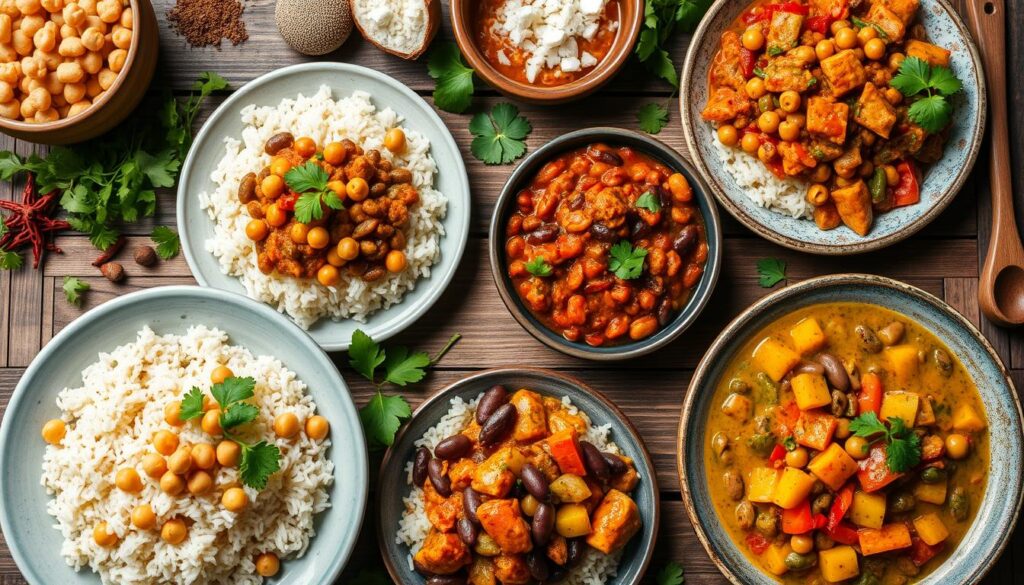
Tips for Storing and Reheating
After savoring a delicious meal of curry rice and beans, I often find myself wanting to enjoy the leftovers later. Proper food storage is key to maintaining the meal’s taste and food freshness. I like to share my best meal prep tips that help keep my dishes ready to reheat deliciously.
Best Practices for Freshness
To extend the shelf life of my leftover curry rice and beans, I follow a few essential practices:
- Allow the dish to cool down to room temperature before storing.
- Use airtight containers to minimize air exposure and prevent spoilage.
- Label containers with the date to keep track of freshness.
- Store in the refrigerator for up to three to four days or freeze for longer preservation.
Ideal Reheating Techniques
When it’s time to enjoy those leftovers, I have a few tried-and-true methods for reheating curry:
- Stovetop: Pour the curry into a saucepan over low heat, stirring constantly until heated through.
- Microwave: Place the curry in a microwave-safe container. Heat in 30-second intervals, stirring in between for even heating.
- Oven: Preheat the oven to 350°F, cover the dish with foil, and bake for about 20 minutes or until warmed to my liking.
Conclusion and Final Thoughts
As I continue my culinary adventures, I find that incorporating Curry Rice and Beans into my meals has truly enhanced my dining experience. This vibrant dish not only delights the palate but also serves as a canvas for creativity in the kitchen. Finding the right *cooking supplies* allows me to explore various flavors while maintaining the authenticity of the dish.
Embracing the versatility of Curry Rice and Beans opens up a world of *recipe exploration*. There’s something gratifying about combining different spices, beans, and types of rice to craft a personalized version. Whether adding seasonal vegetables or experimenting with flavors from other cuisines, each dish becomes unique and reflective of my taste preferences.
I encourage everyone to approach cooking with an open mind and a sense of joy. Don’t hesitate to try out new ingredients or techniques; each attempt can lead to delicious surprises. After all, cooking should be an enjoyable adventure that brings out the chef in all of us, enriching our daily meals with bold flavors and creativity.

